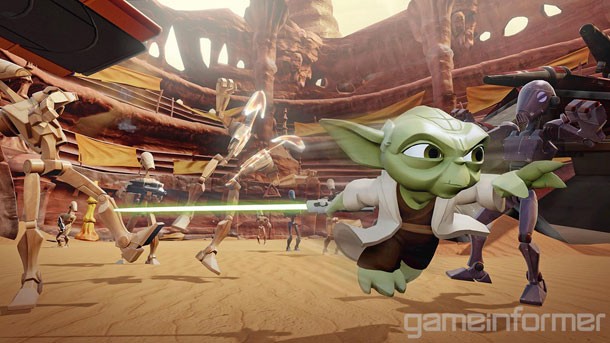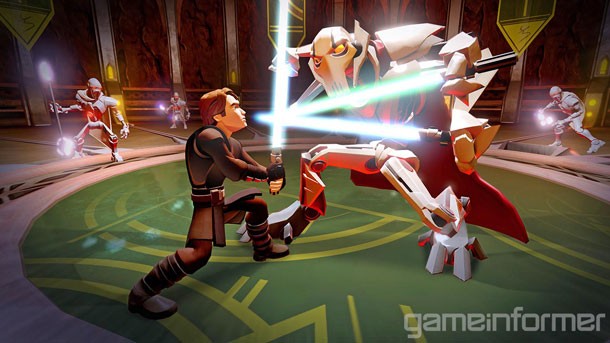Our extra-large special edition is here. Subscribe today and receive the 25% longer issue at no extra cost!
Fighting The Clone Wars: Ninja Theory's Take On Star Wars

Combat in Disney Infinity and its follow-up, 2.0, was simple by design. The game is, after all, geared towards younger players and their families. Avalanche didn’t want to use that as a crutch for boring combat, however, so it sought out Ninja Theory, a studio with a history of combat-heavy action games that recently saw a great deal of success with its Devil May Cry reboot. They were tasked to help improve Infinity across the board – not just for Star Wars.
From a distance, Ninja Theory being involved with Disney Infinity may seem like an odd pairing. Its games regularly explore mature themes and do not shy from violence, but it’s a team Lucas had been interested in for some a while. “[Lucas had] been wanting to work with these guys for a long time,” says John Vignocchi, vice president of production for Disney Infinity. “We immediately had signoff from Lucasfilm; they were excited that Ninja Theory was going to be working on lightsaber combat for us.”
Ninja Theory was on board for Disney Infinity’s Marvel playsets in 2.0 and helped develop and clean up the game’s combat. As early as six months before the completion of 2.0, Ninja Theory was working on lightsaber combat. And it goes much deeper than just crafting new animations and combos for Star Wars’ iconic weapon. “One of the first things we did was to look at what was creating the lag from a technical standpoint, and we had coders looking into it and trying to cut it where we could,” Ninja Theory tells us. “We made sure the animations start immediately, so when you press a button there is already movement and gives you that feeling of responsiveness.” Ninja Theory’s work is distributed throughout Disney Infinity 3.0, meaning those improvements help everybody’s combat. Even Disney Infinity 1.0 characters like Mr. Incredible will play better than they ever have thanks to Ninja Theory’s improvements when you bring them into 3.0.

The Combat
For younger players, mashing a single attack button will still get the job done, but Avalanche and Ninja Theory are hoping those seeking depth will be rewarded. We saw characters like Luke Skywalker (who can use both a blaster and a lightsaber) juggling enemies in the air like Dante. Pausing mid-combo and holding down buttons will also branch your attack off in different combo directions, and the characters with control over the Force can push and pull enemies in an impressive show of force.
A smart example of lessons learned form Devil May Cry comes from Anakin’s special attack, where he uses the force to craft a giant ball of loose trash in the air and brings it crashing down on his enemies. In the past, this would have been a passive attack with players waiting while Anakin gathered and released his attack watching a dedicated animation. Now, players are in full control and can release the attack early, even if the ball of Force-powered trash hasn’t reached its full potential. It’s a good example of how the action is always in the players’ control, even in the middle of special attacks.
Some of the more confusing aspects of combat from the first two Infinity games have also been addressed. In previous games, auto-lock forced you to move toward the enemies you were attacking if you were playing as a character that used guns or blasters – a counterintuitive approach to taking on your target Avalanche admitted. Now, firing on an enemy will lock you onto a target, and you can flick between targets. Alternatively, the option to enter manual targeting continues to exist as well.
For more on Disney Infinity 3.0, click tha banner below for our month of coverage.

The Story
Ninja Theory is doing more than just expanding the combat – it also crafting the playset that frames the action of the prequel trilogy. The story takes place after the second movie when Anakin has not yet embraced the dark side, and he as well as the other Jedi have reached the height of their abilities. The playset begins on Geonosis with players exploring the mysteriously reactivated Droid factory, giving you the opportunity to explore the factory from the films that seemed designed from the start to appear in a video game. From there, players will cross paths with General Grievous, Jabba the Hutt, Cad Bane, Mace Windu, Sebulba, Darth Maul, and many others across planets like Coruscant and Tattooine.
If you keep up with the Clone Wars TV show, you may wonder why like Obi-Wan doesn’t wear his Stormtrooper gauntlets, why Ahsoka doesn’t have her short lightsaber, and why Darth Maul is still a complete person with two attached legs. While the Twilight of the Republic playset is authentic in the Star Wars canon and does properly slot in the timeline, it still maintains Disney Infinity’s core conceit that these games star toy versions of notable characters in a toy playground. For that reason, Lucas and Avalanche opted to use the most iconic versions of the characters for its designs and technically, it is not a canonical story.
Avalanche and Ninja Theory are determined not to squander the opportunity to help reignite the excitement surrounding the Star Wars franchise and its associated video games. "There’s lots more variety. You’re not just battling wave after wave of frost giants.” Vignocchi says, specifically citing one of our own complaints about Disney Infinity 2.0. The changes to Disney Infinity 3.0 are widespread and go much deeper than adding enemy variety, and Ninja Theory has had a big hand in that. It’s a studio Avalanche is eager to have on board and is clearly excited about the work it has already done. “Ninja Theory isn’t a developer that has a hard time finding work,” Vignocchi says, emphasizing his excitement to be working with the team.
For more on Disney Infinity 3.0, click tha banner below for our month of coverage.

Get the Game Informer Print Edition!
Explore your favorite games in premium print format, delivered to your door.
- 10 issues per year
- Only $4.80 per issue
- Full digital magazine archive access
- Since 1991










